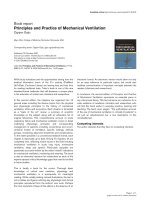Hotline: 0966285892 PDF Principles and Practice of Pediatric Plastic Surgery 2ed 2016,
Bạn đang xem bản rút gọn của tài liệu. Xem và tải ngay bản đầy đủ của tài liệu tại đây (571.78 KB, 5 trang )
Principles and Practice of Pediatric Plastic Surgery, Second Edition - Two Volume
Set, 2nd Edition
Page 1 of 1
v
Front Matter
Dedication
For Kim, Gretchen, Alex, and Eric, who continue to make it hard to be at work, because it is so fun being at
home.
M.L.B.
To my wife, Sally, for unwavering support throughout my career, and acceptance of her role as muse for
my creative efforts, both surgical and artistic; to my family, Erik and Mandy; and to my grandsons, Carson
and Graham, who continue to provide an example of how to keep life in balance.
B.S.B.
To my parents, Philip and Esther, who allowed and encouraged me to pursue my dreams; to my wife, Gail,
who keeps me focused and on track; to my children, Jeremy, Andrew, and Philip, for their energy and
inspiration; and to my adorable grandchildren, Jack, Ryan, and Luke, for making it all worthwhile.
R.M.Z.
v
vi
EXECUTIVE EDITOR Sue Hodgson
SENIOR PROJECT EDITING MANAGER Carolyn Reich
SENIOR DEVELOPMENTAL EDITOR Megan Fennell
DEVELOPMENTAL EDITOR Kathleen Sartori
GRAPHICS MANAGER Brett Stone
DIRECTOR OF ILLUSTRATION AND DESIGN Brenda Bunch
ILLUSTRATORS Brenda Bunch, Christopher Smith, Jennifer N. Gentry, Eric Olson, Morgan
Noonan
SENIOR MANAGING EDITOR Suzanne Wakefield
PROJECT MANAGER Glenn Floyd
MANUSCRIPT EDITORS Idelle Winer, Rebecca Sweeney, Glenn Floyd
PRODUCTIONISTS Susan Trail, Debra Clark, Chris Lane
Principles and Practice of Pediatric Plastic Surgery, Second Edition - Two Volume
Set, 2nd Edition
Page 1 of 2
PROOFREADER Linda Maulin
INDEXER Matthew White
Principles and Practice of Pediatric Plastic Surgery, Second Edition - Two Volume
Set, 2nd Edition
vi
Page 2 of 2
499
21 Secondary Deformities of the Cleft Lip and Nose
Jeremy P. Warner
Bruce S. Bauer
Most cleft lip patients seen for revision have relatively minor deformities, because the principles described in
Chapters 19 and 21 were followed for the primary repair, with attention to the critical landmarks and
meticulous technique. A cleft lip nasal deformity may be the most visible evidence of a prior cleft. Busy cleft
surgeons see patients whose lip repairs were carried out by less skilled surgeons and whose complications of
healing and scar management have resulted in quite significant deformity. Revisions range from minor
realignment of landmarks with direct excision or Z-plasty to major revisions involving full-thickness layered
repair or Abbé flap reconstruction. This chapter presents a review of the more common minor revision
procedures and a discussion of the principles of major lip revision. The main focus is an in-depth discussion of
the treatment of secondary deformities of the cleft lip nose.
We think that a thorough understanding of the nasal deformities seen and the procedures required to correct
them best begins with a brief discussion of the primary deformities of unilateral and bilateral clefts. Surgeons’
opinions vary regarding the appropriate degree of primary correction and how much of the deformity remains
for secondary correction. Most surgeons who routinely perform cleft lip repair agree that an uncorrected nasal
deformity will belie even the best lip repair and invisible scar. Excessive dissection in a primary nasal repair
may affect long-term nasal growth. Surgeons respect this to various degrees depending on their comfort level.
Therefore the spectrum of secondary nasal deformities varies from minor asymmetries to marked asymmetry,
hypoplastic growth, and airway obstruction at skeletal maturity.
499
500
SECONDARY LIP DEFORMITIES
Isolated secondary lip deformities can develop in an otherwise well-performed lip repair and can be
corrected by minor revisions. When a primary repair was not performed optimally, these deformities may
not be isolated and are better addressed by a major revision. Lip shape, symmetry, movement, and associated
nasal symmetry are dependent not only on alignment of the soft tissue landmarks, but also on the bony
support beneath the lip and nose. Proper release of the soft tissues during a repair may provide excellent
symmetry even in the presence of underlying maxillary hypoplasia, but failure to fully release the lip and
nasal structures can result in significant collapse of the soft tissue with increased deformity even when the
lip has been well repaired otherwise. Most lip revision procedures are relatively straightforward, whereas
others defy simple explanation. For these cases, surgeons need to “separate the parts” and occasionally rely
on basic plastic surgical ingenuity to place them in the final symmetrical position (Fig. 21-1).
Principles and Practice of Pediatric Plastic Surgery, Second Edition - Two Volume
Set, 2nd Edition
Page 1 of 2
Fig. 21-1 A, Relatively minor asymmetry with fullness of the vermilion and
mucosa, symmetrical lip length and shape of the Cupid's bow, and
drift of the alar base. B, Symmetry of the lip and nose is
overshadowed by the significant collapse of the alar base and
heminose, which resulted from a pronounced deficiency of the
underlying bone. C, Although the nose is relatively symmetrical, the
repair did little to align the lip landmarks or correct the underlying
muscle. What remains is similar to an occult cleft. D, Initially, this
appeared to be a slightly short cleft side with a displaced columella.
It was actually related to the whole lip being oriented off midline,
with the columella vertically in line with the high point of the
Cupid's bow. E, In this case, the deformity of the lip and nose are
from an atypical shift of the columella to overlie the normal peak
of the Cupid's bow. This may have happened secondary to early
overresection in the nostril floor on the noncleft side. The lip is
elongated on the normal side to a greater degree than it is short on
the cleft side. F, This bilateral repair is similar to a lip adhesion,
because it lacks a muscle repair and alignment of the
vermilion-cutaneous or vermilion-mucosal junction to augment the
central tubercle.
500
Principles and Practice of Pediatric Plastic Surgery, Second Edition - Two Volume
Set, 2nd Edition
Page 2 of 2









